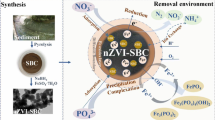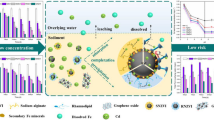Abstract
To probe the effect of common coexist substances on the nitrate removal by polymeric resin supported nanoscale zero-valent iron composite (D201-nZVI), humic acid (HA) was added into the nitrate removal system to elaborate the different interactions between each two and among all in the system including HA, nitrate, and D201-nZVI. The results showed that the effect of HA on the reduction of nitrate by D201-nZVI was concentration-dependent. At low HA concentration (< 5 mg/L), HA coating formed by the HA adsorption on the surface of the nZVI particles enhanced the dispersion of the particles, which led to a more evenly distribution of nZVI particles in the solution, and thus a higher nitrate reduction activity. When HA concentration was increased to 5 mg/L or more, the competitive adsorption of HA and NO3− on the surfaces of the D201-nZVI dominated, and the nitrate removal rate and ammonia nitrogen production were decreased. When the HA concentration reached to a further high level (> 20 mg/L), HA acted as an electron shuttle to accelerate the reduction of Fe(III) to Fe(II) in the D201-nZVI, and thus the nitrate reduction rate was accordingly enhanced. The ammonia production increased by 24.8% at HA concentration of 40 mg/L as compared with that of the control (without addition of HA). This research elucidated the interaction of HA within different HA concentration in the complicate system of anions removal by organic support-nanoscale metal particle composite, which may shade some new light on the potential application of nanoscale zero-valent materials in the practical remediation of natural water.






Similar content being viewed by others
References
Baalousha, M. (2009). Aggregation and disaggregation of iron oxide nanoparticles: influence of particle concentration, pH and natural organic matter. The Science of the Total Environment, 407(6), 2093–2101.
Bhatnagar, A., & Sillanpää, M. (2011). A review of emerging adsorbents for nitrate removal from water. Chemical Engineering Journal, 168(2), 493–504.
Buffle, J. (2006). The key role of environmental colloids/nanoparticles for the sustainability of life. Environment and Chemistry, 3(3), 155–158.
Calderon, B., & Fullana, A. (2015). Heavy metal release due to aging effect during zero valent iron nanoparticles remediation. Water Research, 83, 1–9.
Chang, M. C., Shu, H. Y., Hsieh, W. P., & Wang, M. C. (2005). Using nanoscale zero-valent iron for the remediation of polycyclic aromatic hydrocarbons contaminated soil. Journal of the Air & Waste Management Association, 55(8), 1200–1207.
Chen, J., Xiu, Z., Lowry, G. V., & Alvarez, P. J. (2011). Effect of natural organic matter on toxicity and reactivity of nano-scale zero-valent iron. Water Research, 45(5), 1995–2001.
Crane, R. A., & Scott, T. B. (2012). Nanoscale zero-valent iron: future prospects for an emerging water treatment technology. Journal of Hazardous Materials, 211-212, 112–125.
Delay, M., Dolt, T., Woellhaf, A., Sembritzki, R., & Frimmel, F. H. (2011). Interactions and stability of silver nanoparticles in the aqueous phase: influence of natural organic matter (NOM) and ionic strength. Journal of Chromatography. A, 1218(27), 4206–4212.
Eaton, A. D., Clescerl, L. S., & Greenberg, A. E. (1995). Standard method for the examination of water and waste water (19th ed.). Washington, DC: American Public Health Association, American Water Works Association, Water Environment Federation.
Hwang, Y. H., Kim, D. G., & Shin, H. S. (2011). Mechanism study of nitrate reduction by nano zero valent iron. Journal of Hazardous Materials, 185(2–3), 1513–1521.
Illés, E., & Tombácz, E. (2004). The role of variable surface charge and surface complexation in the adsorption of humic acid on magnetite. Colloid Surface A, 230(1–3), 99–109.
Illés, E., & Tombácz, E. (2006). The effect of humic acid adsorption on pH-dependent surface charging and aggregation of magnetite nanoparticles. Journal of Colloid and Interface Science, 295(1), 115–123.
Jiang, Z., Lv, L., Zhang, W., Du, Q., Pan, B., Yang, L., & Zhang, Q. (2011). Nitrate reduction using nanosized zero-valent iron supported by polystyrene resins: role of surface functional groups. Water Research, 45(6), 2191–2198.
Johnson, R. L., Johnson, G. O., Nurmi, J. T., & Tratnyek, P. G. (2009). Natural organic matter enhanced mobility of nano zerovalent iron. Environmental Science & Technology, 43, 5455–5460.
Joo, S. H., Feitz, A. J., & Waite, T. D. (2004). Oxidative degradation of the carbothioate herbicide, molinate, using nanoscale zero-valent iron. Environmental Science and Technology, 38, 2242–2247.
Kang, S., & Xing, B. (2008). Humic acid fractionation upon sequential adsorption onto goethite. Langmuir, 24, 2525–2531.
Kim, S. A., Kamala-Kannan, S., Lee, K. J., Park, Y. J., Shea, P. J., Lee, W. H., Kim, H. M., & Oh, B. T. (2013). Removal of Pb(II) from aqueous solution by a zeolite–nanoscale zero-valent iron composite. Chemical Engineering Journal, 217, 54–60.
Klas, S., & Kirk, D. W. (2013). Advantages of low pH and limited oxygenation in arsenite removal from water by zero-valent iron. Journal of Hazardous Materials, 252-253, 77–82.
Kumar, N., Auffan, M., Gattacceca, J., Rose, J., Olivi, L., Borschneck, D., Kvapil, P., Jublot, M., Kaifas, D., Malleret, L., Doumenq, P., & Bottero, J. Y. (2014). Molecular insights of oxidation process of iron nanoparticles: spectroscopic, magnetic, and microscopic evidence. Environmental Science & Technology, 48(23), 13888–13894.
Li, X., & Shang, C. (2005). Role of humic acid and quinone model compounds in bromate reduction by zerovalent iron. Environmental Science & Technology, 39, 1092–1100.
Li, X. Q., Elliott, D. W., & Zhang, W. X. (2006). Zero-valent iron nanoparticles for abatement of environmental pollutants: materials and engineering aspects. Critical Reviews in Solid State, 31(4), 111–122.
Liao, C. H., Kang, S. F., & Hsu, Y. W. (2003). Zero-valent iron reduction of nitrate in the presence of ultraviolet light, organic matter and hydrogen peroxide. Water Research, 37(17), 4109–4118.
Liao, D. (2009). Kinetics of removing nitrate by nanoscale zero-valent iron. Chinese Journal of Environmental Engineering, 3(6): 985–989.
Liu, Y. C., Dionysios, H. C., & Lowry, G. V. (2005a). Trichloroethene hydro-dechlorination in water by highly disordered monometallic nanoiron. Chemistry of Materials, 17, 5315–5322.
Liu, Y. C., Majetich, S. A., Tilton, R. D. Sholl, D. S., Lowry, G. V.. (2005b). TCE dechlorination rates, pathways, and efficiency of nanoscale iron particles with different properties. Environmental Science & Technology 39(1338–1345).
Luo, S., Qin, P., Shao, J., Peng, L., Zeng, Q., & Gu, J. D. (2013). Synthesis of reactive nanoscale zero valent iron using rectorite supports and its application for Orange II removal. Chemical Engineering Journal, 223, 1–7.
Lv, X., Xu, J., Jiang, G., Tang, J., & Xu, X. (2012). Highly active nanoscale zero-valent iron (nZVI)-Fe3O4 nanocomposites for the removal of chromium(VI) from aqueous solutions. Journal of Colloid and Interface Science, 369(1), 460–469.
Manciulea, A., Baker, A., & Lead, J. R. (2009). A fluorescence quenching study of the interaction of Suwannee River fulvic acid with iron oxide nanoparticles. Chemosphere, 76(8), 1023–1027.
Neumann, A., Kaegi, R., Voegelin, A., Hussam, A., Munir, A. K., & Hug, S. J. (2013). Arsenic removal with composite iron matrix filters in Bangladesh: a field and laboratory study. Environmental Science & Technology, 47(9), 4544–4554.
Ryu, A., Jeong, S. W., Jang, A., & Choi, H. (2011). Reduction of highly concentrated nitrate using nanoscale zero-valent iron: effects of aggregation and catalyst on reactivity. Applied Catalysis B: Environmental, 105(1–2), 128–135.
Shi, J., Yi, S., He, H., Long, C., & Li, A. (2013). Preparation of nanoscale zero-valent iron supported on chelating resin with nitrogen donor atoms for simultaneous reduction of Pb2+ and NO3 −. Chemical Engineering Journal, 230, 166–171.
Shimizu, A., Tokumura, M., Nakajima, K., & Kawase, Y. (2012). Phenol removal using zero-valent iron powder in the presence of dissolved oxygen: roles of decomposition by the Fenton reaction and adsorption/precipitation. Journal of Hazardous Materials, 201-202, 60–67.
Shuang, C., Wang, M., Zhou, Q., Zhou, W., & Li, A. (2013). Enhanced adsorption and antifouling performance of anion-exchange resin by the effect of incorporated Fe3O4 for removing humic acid. Water Research, 47(16), 6406–6414.
Sohn, K., Kang, S. W., Ahn, S., Woo, M., & Yang, S. K. (2006). Fe(0) nanoparticles for nitrate reduction: stability, reactivity, and transformation. Environmental Science & Technology, 40, 5514–5519.
Song, H., Yao, Z., Wang, M., Wang, J., Zhu, Z., & Li, A. (2013). Effect of dissolved organic matter on nitrate-nitrogen removal by anion exchange resin and kinetics studies. Journal of Environmental Science China, 25(1), 105–113.
Su, C., & Puls, R. W. (2004). Nitrate reduction by zerovalent iron: effects of formate, oxalate, citrate, chloride, sulfate, borate, and phosphate. Environmental Science & Technology, 38(9), 2715–2720.
Tombácz, E., Tóth, I. Y., Nesztor, D., Illés, E., Hajdú, A., Szekeres, M., et al. (2013). Adsorption of organic acids on magnetite nanoparticles, ph-dependent colloidal stability and salt tolerance. Colloids Surfaces A, 435(9), 91–96.
Vindedahl, A. M., Strehlau, J. H., Arnold, W. A., & Penn, R. L. (2016). Organic matter and iron oxide nanoparticles: aggregation, interactions, and reactivity. Environmental Science: Nano, 3(3), 494–505.
Xu, J., Hao, Z., Xie, C., Lv, X., Yang, Y., & Xu, X. (2012). Promotion effect of Fe2+ and Fe3O4 on nitrate reduction using zero-valent iron. Desalination, 284, 9–13.
Yang, K., Lin, D., & Xing, B. (2009). Interactions of humic acid with nanosized inorganic oxides. Langmuir, 25, 3571–3576.
Zhang, Y., Chen, Y., Westerhoff, P., Hristovski, K., & Crittenden, J. C. (2008). Stability of commercial metal oxide nanoparticles in water. Water Research, 42(8–9), 2204–2212.
Zhang, Q., Du, Q., Jiao, T., Pan, B., Zhang, Z., Sun, Q., et al. (2013a). Selective removal of phosphate in waters using a novel of cation adsorbent: zirconium phosphate (zrp) behavior and mechanism. Chemical Engineering Journal, 221(2), 315–321.
Zhang, Q., Du, Q., Hua, M., Jiao, T., Gao, F., & Pan, B. (2013b). Sorption enhancement of lead ions from water by surface charged polystyrene-supported nano-zirconium oxide composites. Environmental Science & Technology, 47(12), 6536–6544.
Zhang, Q., Li, Y., Phanlavong, P., Wang, Z., Jiao, T., Qiu, H., & Peng, Q. (2017). Highly efficient and rapid fluoride scavenger using an acid/base tolerant zirconium phosphate nanoflake: behavior and mechanism. Journal of Cleaner Production, 161, 317–326.
Zhang, Q., Li, Y., Yang, Q., Chen, H., Chen, X., Jiao, T., & Peng, Q. (2018). Distinguished Cr(VI) capture with rapid and superior capability using polydopamine microsphere: behavior and mechanism. Journal of Hazardous Materials, 342, 732–740.
Acknowledgments
This research is supported by the Natural Scientific Foundation of China (Grant No. 21207110 and 41771347) and the National Key Research and Development Program of China (2017YFD0800903).
Author information
Authors and Affiliations
Corresponding author
Rights and permissions
About this article
Cite this article
Wang, L., Zhou, H., Liu, J. et al. Effect of Humic Acid on the Nitrate Removal by Strong Base Anion Exchanger Supported Nanoscale Zero-valent Iron Composite. Water Air Soil Pollut 229, 357 (2018). https://doi.org/10.1007/s11270-018-3988-6
Received:
Accepted:
Published:
DOI: https://doi.org/10.1007/s11270-018-3988-6




